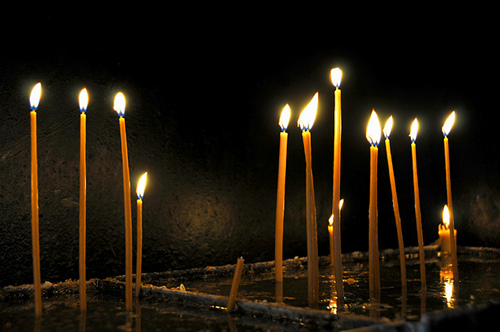“So if I want Mexicans to learn the name of Quetzalcoatl, it is because I want them to speak with the tongues of their own blood. I wish the Teutonic world would once more think in terms of Thor and Wotan, and the tree Igdrasil. And I wish the Druidic world would see, honestly, that in the mistletoe is their mystery, and that they themselves are the Tuatha De Danaan, alive, but submerged. And a new Hermes should come back to the Mediterranean, and a new Ashtarot to Tunis; and Mithras again to Persia, and Brahama unbroken to India, and the oldest of dragons to China.” —D.H. Lawrence, The Plumed Serpent
As early as in 1968, Alain de Benoist founded in France the Groupement de recherche et d’études pour la civilisation européenne, a ethnonationalist think-tank that rejected Christianity and advocated a return to Paganism. A few years before, at Findhorn, in Scotland, what we now call New Age was born. Those who did not buy the materialistic and atheistic propaganda of the secular West, but who at the same time no longer felt that the answers to their spiritual needs would be found in Christianity, were searching for new options.
For years a student of comparative religion and of scholarly esoterica, I myself find Neopaganism to be a viable prospect, especially in Europe, while Traditionalism of the sort advocated by René Guénon, Frithjof Schuon, Ananda Coomaraswamy, Titus Burckhardt, Julius Evola and other 20th century Traditionalists seems realistically untenable. In other words, despite my good will, I find praying to, say, Mercury, or Odin, or Mithras bordering on the impractical, if not on the silly. On the other hand, many of the deities belonging to Greco-Roman mythology were de facto incorporated into the Roman Catholic religion. The latter, despite its claims to the opposite, is thoroughly polytheistic, owing to its belief in the Trilogy; in an overabundance of male and female saints; and in the Holy Virgin, worshipped through a multitude of apparitions in different countries and even regions within the same country. It couldn’t be otherwise, given the inescapable influence of the mythology Roman Catholicism eventually supplanted.
One feature that distinguishes Catholicism from the other Christian sects, and indeed from all Abrahamic religions, is the mentioned cult of the Virgin, i.e., the cult of the Goddess. It goes without saying — quite literally: no member of the Catholic clergy would ever admit as much openly — that, within the Catholic religion, Our Lady is at once Cybele, Minerva, Diana, and various other goddesses of antiquity. One festivity above all illustrates this: the 15th of August is the Feast of the Assumption, the Assumption of the Virgin Mary into Heaven. In Italy such a feast is to this day called “Ferragosto”. The whole country shuts down, and in that, as well as in popularity, it rivals Christmas. In fact, “Ferragosto” comes from the Latin “Feriae Augusti” (Augustus’s rest), a celebration established by Emperor Augustus in 18 BC to celebrate the harvest, the cycle of fertility and ripening, and ultimately the goddess Diana.
Consequently praying to the Blessed Virgin Mary conjures up much earlier goddesses, too, of which she has become, so to speak, a repository. None of this was clear to me until about fifteen years ago, and I still marvel at this neopagan phenomenon in disguise.
When travelling across Catholic Europe in particular, one chances upon a number of Marian shrines, erected to celebrate her apparition in a specific place. Some people will be devoted to, say, the Virgin of Loreto, others of Lourdes, or of Fatima—it’s always the same Virgin, of course, but once more she would seem to be reasserting her inherent polytheistic traits by being worshiped under different names.
Recently my wife and I celebrated an important wedding anniversary by motoring across Spain and France. Willy-nilly, the sub-theme of our grand tour turned out to be Our Lady.
Even in Girona, the first place we stayed at and were using as a base from which to explore Salvador Dalí’s stomping grounds, we chanced upon a magnificent Gothic cathedral, originally the Roman forum atop a flight of steps, dedicated to Nuestra Señora (Our Lady).
We then paused briefly in Zaragoza to pay homage to Nuestra Señora del Pilar (Our Lady of the Pillar). Then on to Burgos, with its supremely rich and gorgeous Gothic cathedral, also dedicated to Nuestra Señora. The same goes for Léon’s impressive cathedral with acres of stained glass windows. Covadonga, in Asturias, is a Marian pilgrimage for the whole of Spain; that’s where a Visigothic king-to-be, Pelagius, by winning a battle against the Moors — who hated the rainy climate anyway — made sure that Asturias would never be conquered. Pelagius/Pelayo was helped in this battle by the Virgin. From a mini-kingdom born in a cave deep in the Asturian mountains to a world power and today a world language—who would have thought…
Over in France, our first stop was Rocamadour, not only for Durendal, paladin Roland’s sword stuck in the stone, but of course for Notre Dame (Our Lady), to whom the whole magnificently stratified medieval complex carved out of sheer rock is dedicated. Rouen and Paris have magnificent cathedrals dedicated to Notre Dame, too.
And yet, out of all these places, the one that “spoke” to both my wife and to me was the Basilica-Catedral de Nuestra Señora del Pilar, in Zaragoza.
I should contextualize our visit.
This was a mere stop, coming from Girona on the way to Burgos. Being the longest transfer in our grand tour (670 kms), there was no time to waste. Also, it happened to be a Sunday, and the Basilica-Catedral was predictably crammed—but at least with the faithful, hence being used for what it was intended, as a place of worship rather than as a museum, which is the case, for example, in Burgos. I try to be a careful driver, and am extremely concentrated when driving on highways or anywhere at high speed. But when I get to a town or to a city, I relax and decompress. After all, an accident in a parking lot is a scratch, or a dent, while an accident on a highway can easily be deadly. My wife, on the other hand, gets restless amid traffic and quite impatient in a parking lot, I suppose out of eagerness to have arrived already. So while I relax she tends to tense up. In an underground parking by the Basilica-Catedral I was a having trouble getting the maneuver right to park our largish Kia Carens (Carens? Would you believe the name the Koreans gave it? From the Latin, “lacking”?). We bickered, and I said, “If you’re so good at it, park it yourself.” She didn’t like such effrontery, but went ahead and parked the car. As we emerged in the plaza, we were treated to unexpected American spaces and scope: the gargantuan Basilica-Catedral in the center; two more churches at either end of the oblong and immense plaza; and the river Ebro on the other side, crossed there by a glorious Roman bridge. Still in a somewhat distracted mood, we entered the crowded Basilica-Catedral, and quickly found the Virgen del Pilar: a statuette of 14.37 inches exactly standing atop a smallish pillar. That immense plaza with two co-cathedrals and another church of merit; that enormous Basilica-Catedral dating back to the outset of Christianity and then constantly modified over time—all for this? No sooner had my intellect formulated this than I was moved to tears, and started weeping. I have no idea why. My wife, a few footsteps behind me, was equally overwhelmed.
In other Marian shrines along the way we had the place to ourselves, and were in a calmer mood, conducive, one would think, to meditation. It was all the opposite inside the Basilica-Catedral—and yet, we’d never experienced anything of the sort.
In my blissful ignorance, I didn’t know the exact nature of this particular apparition, though I realized it must be portentous as I was surprised to discover, on a previous journey, that the cathedral in Charters is also devoted to the Virgen del Pilar. There it follows:
“According to legend, in the early days of the Church on January 2nd, 40 AD, the Apostle James (Santiago) the Greater was proclaiming the Gospel in Caesaraugusta (present day Zaragoza) by the river Ebro, when he saw Mary miraculously appearing in the flesh on a pillar calling him to return to Jerusalem. The pillar, which was being carried by angels, is believed to be the same one venerated in Zaragoza, Spain today. Miraculous healings have been reported at the location.”
This, I also learned, was the only apparition of the Virgin before her Assumption into Heaven (or Dormition, as the Anglicans call it), i.e., while still alive. It is also the first Marian apparition of them all, and the church originally erected to celebrate it, the first church in Christianity dedicated to Our Lady.
So, the importance of all other Marian shrines we’ve visited before and since notwithstanding (for example, Guadalupe, in Extremadura, Spain, which then, through another apparition across the Atlantic Ocean, became the Patron Saint of Mexico; Loreto, in the Marche, Italy, where the Shrine of the Holy House supposedly contains the house in which the Virgin lived, flown there from across the Adriatic Sea by angels), it is poetic that this one, of them all, would move us so deeply—the one in which the cult of the Virgin was born, and the cult of the Goddess, reborn.
But should you still think of Marianism as a cult exclusively for Catholics, though I’ve been trying to point out its strong pagan connotations, consider the name of the city “Los Angeles”. While often referred to as the City of Angels, its full name is: El Pueblo de Nuestra Señora la Reina de los Ángeles de Porciúncula—“The Town of Our Lady the Queen of Angels of Porziuncola.” The Porziuncola is the little church that Saint Francis of Assisi restored after receiving a mystical vision; another one is the little chapel of Saint Mary of the Angels, which later became his house. On top of the tiny Porziuncala was built the huge Basilica of Saint Mary of the Angels. So even Los Angeles happens to have a distinctly Marian origin—and resonance?
Image by Dennis Jarvis, courtesy of Creative Commons license.















